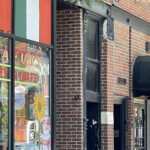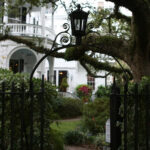Broadway in Nashville is more than just a street; it’s a vibrant artery pumping the lifeblood of country music and Southern charm through the heart of Music City. From its humble beginnings as a port access route to its current status as the Honky Tonk Highway, Broadway has a rich and storied past that continues to evolve, drawing millions of visitors each year. Whether you’re a country music aficionado, a history enthusiast, or simply looking for a good time, Nashville Broadway Street promises an unforgettable experience.
From Riverfront Roots to “Auto Row”: The Early Days of Broadway
Broadway’s story begins in the early days of Nashville, when the Cumberland River was the city’s lifeline. The eastern end of Broad Street, now known as Lower Broadway, served as the crucial link between the bustling wharfs and docks and the burgeoning city center. Market Street, now Second Avenue, connected the waterfront to the public square’s vendor stalls, establishing Broadway as a vital commercial thoroughfare. In the original city plan, Broadway was one of only three east-west roadways, highlighting its early importance.
Initially, Broadway was lined with practical establishments that fueled Nashville’s growing economy: hardware stores, feed shops, and various enterprises catering to the needs of a developing city. A significant milestone in Broadway’s history occurred in 1875 when it became home to Nashville’s first public high school, marking its growing importance beyond just commerce.
As the 20th century dawned, Broadway underwent another transformation, becoming known as “Auto Row.” The rise of the automobile saw a proliferation of car dealerships, tire stores, and auto parts shops lining the street, reflecting the changing times and Nashville’s embrace of modern transportation.
During the Great Depression, another significant structure emerged near Broadway. The Work Progress Administration (WPA) constructed a new post office adjacent to Union Station, capitalizing on the railway’s dominance in mail transport. While Union Station has since been elegantly repurposed into a luxury hotel, the Old Post Office now serves as the Frist Art Museum, a testament to Broadway’s ability to adapt and repurpose its historical spaces.
Honky Tonk Highway: Broadway’s Anthem of Country Music
The transformation of Broadway into the legendary Honky Tonk Highway began in the 1930s. Jimmy Rodgers, a pioneer of country music, started performing in the honky tonks of Lower Broadway, setting the stage for the street’s musical destiny. As Rodgers’ fame soared, aspiring singers and songwriters flocked to the area, drawn by the burgeoning country music scene.
This four-block stretch of Broadway became the undisputed heart of country music, earning the evocative nickname “Honky Tonk Highway,” a title that places it alongside other iconic music streets like Bourbon Street in New Orleans and Beale Street in Memphis. The bars and music venues along this stretch became launchpads for countless legendary performers, solidifying Broadway’s place in music history.
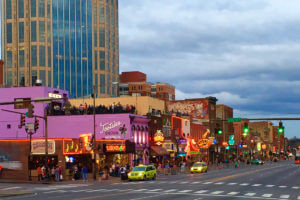 nashville tootsies orchid lounge
nashville tootsies orchid lounge
However, Broadway’s fortunes fluctuated. When the Grand Ole Opry, country music’s most famous show, moved out of the Ryman Auditorium in the 1970s, Broadway experienced a period of decline. But the story doesn’t end there. Approximately two decades later, the resurgence of the Ryman Auditorium acted as a catalyst, sparking a revitalization of the entire area and breathing new life into Broadway.
Today, Broadway is a vibrant mix of old and new. Historic commercial buildings, such as the Victorian-era former Merchants Hotel, now house a diverse array of country western-themed shops, restaurants, and, of course, the honky tonks that made it famous. These establishments are the lifeblood of Broadway, offering cold drinks and live music from early afternoon well into the night.
Walking down Broadway is an experience in itself. The sounds of live music spill out onto the street, creating an infectious energy. You can stroll along, soak in the atmosphere, or grab a seat at a streetside table and immerse yourself in the music. Broadway is known for its impromptu jam sessions, and you never know when a legendary artist might join an up-and-coming performer on stage, making every visit a potentially unique experience.
Must-See Spots on Nashville’s Broadway Street
Broadway boasts a collection of attractions beyond just the honky tonks. Several points of interest are recognized for their historical and cultural significance, offering a deeper exploration of Nashville’s heritage.
Union Station Hotel
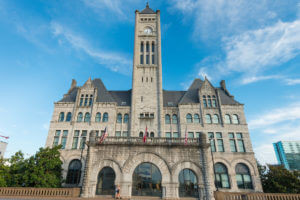 nashville union station
nashville union station
Originally built in 1900 as a grand railroad depot, Union Station stands as a majestic example of Victorian-era architecture. Today, it has been transformed into a luxury hotel, but it retains the grandeur of its past. Step inside to admire the neo-Romanesque edifice, highlighted by a breathtaking 65-foot-tall lobby topped with a stunning stained glass ceiling. Italian marble and intricate woodwork further enhance the opulent interior. Recognized for its historical importance, Union Station was added to the National Historic Register in 1969.
Frist Art Museum
Housed in the beautifully repurposed Old Post Office, a nationally historic Art Deco landmark completed in 1934, the Frist Art Museum offers a different kind of cultural experience on Broadway. This non-collecting museum hosts a rotating schedule of traveling fine art exhibitions, ensuring there’s always something new and engaging to see. The Frist also showcases the talents of local and regional artists in various media. Architecture enthusiasts can take a tour of the building’s preserved Art Deco interior, held on the first Saturday of each month.
Hume-Fogg Academic Magnet High School
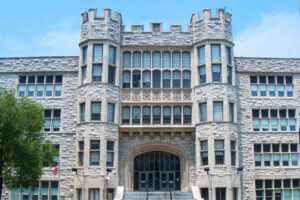 nashville hume fogg magnet high school
nashville hume fogg magnet high school
While not a typical tourist attraction, Hume-Fogg Academic Magnet High School, completed in 1912, is a striking landmark on Broadway. Resembling a medieval European castle, this Norman Gothic stone building, designed by William Ittner, is easily recognizable with its twin tower entrance and Tudor Gothic ornamentation. Look closely at the cut stone figures above the entrance, representing different fields of academic study – literature, mathematics, science, and fine arts – adding a layer of artistic detail to this educational institution.
Bridgestone Arena
For sports and entertainment fans, Bridgestone Arena is a major destination on Broadway. Home to the NHL’s Nashville Predators, this versatile venue hosts a wide range of events, including major indoor concerts and the annual Country Music Association Awards. The arena also houses the Nashville Visitor Center and the Tennessee Sports Hall of Fame, making it a hub of activity and information.
Tootsie’s Orchid Lounge
No visit to Broadway is complete without experiencing Tootsie’s Orchid Lounge. Instantly recognizable by its accidentally purple exterior, Tootsie’s is a world-famous honky tonk with a rich history. It has played a pivotal role in launching the careers of country music legends, including Willie Nelson. Movie buffs might recognize the interior, as scenes from the film Coal Miner’s Daughter were filmed here, adding to its legendary status.
Ernest Tubb Record Shop
For country music purists and collectors, the Ernest Tubb Record Shop is a must-visit. Established in 1947, this retail store is a treasure trove of country and bluegrass albums, memorabilia, and music from both classic and contemporary artists. It’s a step back in time and a chance to discover hidden gems and classic recordings.
Riverfront Station
Located where Broadway meets First Avenue and the Cumberland River, Riverfront Station serves as the western terminus of the Music City Star, Nashville’s regional commuter rail line. Built in 2006, the station’s post and beam architecture is a replica of a historic Tennessee Central Railroad train depot that once stood on the site, connecting Broadway to Nashville’s transportation history.
Riverfront Park
 nashville-riverfront-park
nashville-riverfront-park
At the eastern end of Broadway, where the street meets the Cumberland River, lies Riverfront Park, a green oasis amidst the urban energy. This park offers a variety of recreational amenities, including a playground, a large lawn, the Ascend Amphitheater, an ornamental garden, a mile-long greenway trail, and even a dog park. Riverfront Park is also a popular venue for cultural events and celebrations, most notably the annual Independence Day concert and fireworks display.
Planning Your Visit to Broadway Nashville
Broadway is a year-round destination, but the best time to visit is generally from April to October, coinciding with Nashville’s peak tourist season. Keep in mind that Nashville summers are known for being hot and humid, while winters can bring near-freezing temperatures. Spring and fall offer the most pleasant weather, with mild daytime temperatures and cooler evenings, perfect for enjoying Broadway’s outdoor atmosphere. Dressing in layers is recommended, especially during these shoulder seasons.
For families visiting Nashville, many honky tonks on Lower Broadway are family-friendly during the day, with age restrictions typically enforced later in the evening. This allows families with children to experience the Honky Tonk Highway’s unique atmosphere together. Be aware that Broadway is most crowded on weekends and as evenings progress, attracting both tourists and locals alike.
Explore Beyond Broadway
While Broadway is a central attraction, Nashville offers much more to explore just a short distance away.
Ryman Auditorium
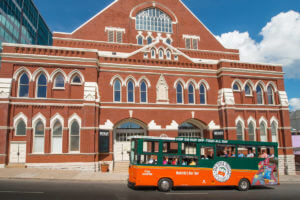 ryman-nashville
ryman-nashville
Known as the “Mother Church of Country Music,” the Ryman Auditorium is an iconic Nashville landmark. This historic venue, which hosted the Grand Ole Opry for three decades, began as a gospel tabernacle in 1892. Today, the Ryman hosts headline musical acts and offers fascinating backstage tours, providing a deeper look into its rich musical history. It was added to the National Register of Historic Places in 1971.
Johnny Cash Museum
Located on Third Avenue South, just a short walk from Broadway, the Johnny Cash Museum celebrates the life and legendary career of “The Man in Black.” The museum features an extensive collection of artifacts and memorabilia related to Johnny Cash, including personal items, musical instruments, and stage costumes, offering an immersive experience into the life of this international icon.
Goo Goo Shop
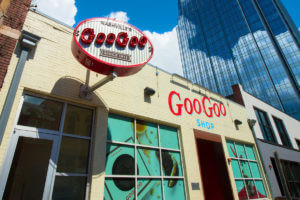 nashville goo goo shop
nashville goo goo shop
Just steps away from Broadway, the Goo Goo Shop is a sweet treat destination. This shop offers a variety of vintage candies, Nashville-themed merchandise, and, most famously, the Goo Goo Cluster, a signature Southern confection made with milk chocolate, marshmallow, caramel, and peanuts. Visitors can even watch these delicious treats being handmade right in the shop.
Broadway in Nashville is a sensory feast, a historical journey, and a musical pilgrimage all rolled into one vibrant street. Come experience the energy, the history, and the sounds of Nashville Broadway Street and create your own Music City memories.

